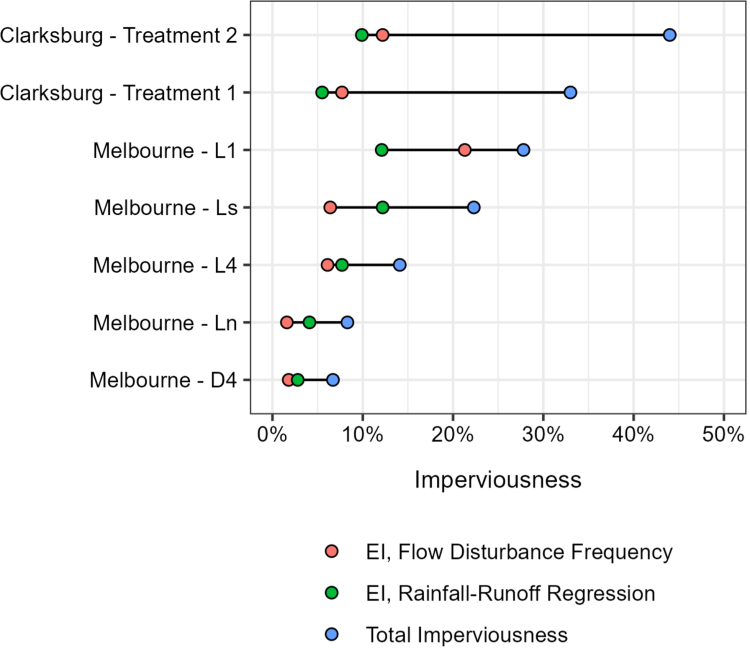What metrics can we use to measure the watershed-scale effect of SCMs?
More stormwater control measures (SCMs) are being used to treat stormwater and prevent stormwater from reaching urban streams. To answer, “How successful are these SCMs at a watershed scale?” we need metrics that can be used to quantify watershed-scale SCM success.
Existing metrics may not work well for settings with many SCMs. For example, total imperviousness assumes SCMs have no effect. In the example below, total imperviousness would come out to 40% for the watershed not taking into account that 1 km2 of the imperviousness drains to an SCM. On the other extreme, directly connected imperviousness assumes SCM work perfectly. In the example below, directly connected imperviousness would come to 20%, which assumes that SCMs are able to remove all the effect of the imperviousness draining to them. If we want to represent the effectiveness of SCMs, we want something in between total and directly connected imperviousness – that represents the actual performance of the SCMs for reducing impervious areas hydraulically connected to the stream. We call this effective imperviousness, which is 25% in the example below.

This work applies two metrics to quantify effective imperviousness: one that measures the frequency of downstream flow disturbances and another that computes parameters from a paired rainfall-runoff regression analysis.

We apply these metrics in two settings with low impact development: Clarksburg, Maryland, USA and Melbourne, Australia. New development in Clarksburg, Maryland was built with dense SCMs. Clarksburg is one of the few monitored areas where 100% of impervious surfaces are treated by SCMs. Another way to say this is that the watersheds have 33% - 44% total imperviousness and 0% directly connected imperviousness. Melbourne watersheds were retrofitted with SCMs. Dispersed SCMs were installed in Little Stringybark and Dobsons Creeks as part of a stream restoration experiment. SCMs were designed to minimize uncontrolled runoff and maximize volume retention, and to restore the quality and volume of dry-weather flows. However, space and harvesting-demand limitations left many impervious areas remained untreated in the Melbourne watersheds.

We found that the two methods gave overall similar results, with effective imperviousness (EI) much lower than total imperviousness.

In Clarksburg, the estimated effective imperviousness of 5-12% compares well with the conditions reflected in the benthic index of biotic integrity. Both methods for effective imperviousness suggest that Treatment 2 is more impacted by urban development than Treatment 1, which matches with the hydrologic and biological outcomes.
Overall, effective imperviousness better described stream hydrologic and stream health outcomes compared to either total imperviousness or directly-connected imperviousness in both settings. This work demonstrates how to apply these approaches in two common stormwater contexts, new development and retrofits, and contributes to efforts to compare stormwater control measure success across watersheds using consistent metrics.
For more information, the full article can be found here:
Bhaskar AS, Stillwell CC, Burns MJ, Hopkins KG, Walsh CJ (2025) Quantifying the success of stormwater control measure networks using effective imperviousness. PLOS Water 4(6): e0000335. https://doi.org/10.1371/journal.pwat.0000335
or contact the corresponding author at aditi.bhaskar@colorado.edu.
There is also a recording of Aditi Bhaskar presenting an earlier version of this work as part of the Minnesota Stormwater Seminar at https://www.youtube.com/watch?v=mYY8HSkwBjA.

